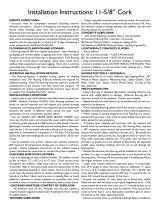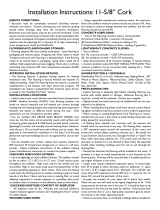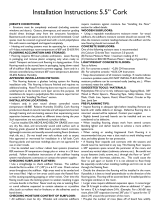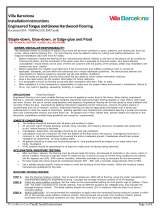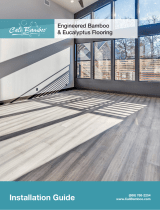Page is loading ...

Floating Installation Instructions:
IMPORTANT INSTALLATION TIPS:
The sub-oor must be at to 3/16” per 8’ radius or oor could ex. In addition to •
causing squeaking, over time the glue bond could weaken or the tongues may crack
causing gaps or loose boards.
Like all wood oors, a oating oor expands and contracts with seasonal changes. •
Do not put fasteners (nails, screws, etc) through the oor or “pinch” the oor under
doorways, etc. This could cause the oor to pull apart or buckle because it is not
allowed to “oat” freely. The required expansion space is equal to the product
thickness. In areas measuring more than 24 lineal feet in either direction (width or
length), use an additional 1/4” expansion for each additional 12 linear feet (i.e. for
a 3/8” product in a room that measures 36’ x 36’ you would leave 5/8” expansion
around all vertical surfaces which can be covered by your choice of molding).
All wood oors require a relative humidity level between 35-55% to perform •
optimally without gapping, cupping, etc. A humidier may be required during the winter
in some homes to achieve these humidity levels. In addition, interior environment
must be maintained between 60-80 degrees year round.
PLEASE NOTE THESE ARE IMPORTANT TIPS TO REMEMBER: PLEASE READ THE •
INSTALLATION INSTRUCTIONS THOROUGHLY BEFORE BEGINNING INSTALLATION.
PRE-INSTALLATION GUARANTEE:
Although each board is subject to stringent quality assurance checks before it •
leaves our factory, the installer should inspect again before installation. Any defects
should be reported, and we will immediately arrange for replacements to be provided.
We offer pre-installation guarantee of our products returned unused/unopened.
PRE-INSTALLATION PLANNING (REQUIREMENTS):
All ooring products must be stored in a climate controlled area, which is equal to •
the environment in which it will be installed.
Planks should be stored at. Do not open cartons until installation begins.•
Flooring should not be delivered to the job until all “wet trade” work (painting, dry •
wall, tile work etc.) has been completed, and the suboor moisture content has been
determined to meet the recommended level required for installation. (See Suboor
Moisture Requirements.)
Engineered ooring can be installed on grade, above grade or below grade.•
Prior to installing the oor, the building must be structurally enclosed, including •
installation of exterior windows and doors.
Heating and cooling systems must be fully operational at least 14 days prior to •
ooring installation, maintaining a minimum room temperature of 60 degrees F.
Gutters, downspouts and exterior grading, should direct drainage away from the •
structure’s foundation.
Basements and crawl spaces must be dry and well ventilated. A 6-mil polyethylene •
(poly) lm must cover the ground of all crawl spaces; seams must be overlapped and
taped.
Decide the direction the ooring will be installed. Planks should be installed •
perpendicular to the ooring joists. Flooring will be accented best, if installed parallel
to windows (if possible).
Preplan the number of rows required to nish the installation. The nal row will •
normally be narrower and have to be ripped lengthwise. If possible, the last row
should be wider than 2”. You may want to rip both the rst and last rows to balance
the installation.
Remove any base, or shoe moldings and interior thresholds. These can be replaced •
after the oor has been installed. Undercut doorjambs to allow for expansion, and
avoid difcult scribe cuts. This can be easily done by using a small piece of the ooring
as a guide for your jamb saw.
Your engineered ooring is NOT guaranteed if it is installed in a full bath.•
Do not use ooring planks or stair nose moldings to build stair treads. Stairnose •
moldings are designed to transition the oor to a step down or set of stairs, not for
individual stair construction.
The use of putty to ll small gaps or correct minor defects should be considered •
normal in any hardwood installation. When using putty on a low gloss (sheen) nish,
apply putty with a plastic putty knife and remove excess immediately with a soft cloth
to prevent gloss up of nish.
Always install from various boxes to ensure accurate mix of color and grade. This •
is extremely important when working with wood species or grades that have natural
color variation.
Never install engineered ooring ush to any vertical obstruction; allow the •
proper expansion space around all vertical surfaces (the expansion space should
be equivalent to the thickness of the ooring). In areas measuring more than 24
lineal feet in either direction (width or length), use an additional 1/4” expansion
for each additional 12 linear feet. (Board thickness only is required for glue and
staple)
GENERAL SUBFLOOR REQUIREMENTS:
All suboors must be at to 3/16” per 8’ radius. If suboor prep is required, •
“high spots” should be sanded or ground down and “low spots” should be lled
and leveled with a quality portland based leveling compound. Do not sand surfaces
such as vinyl or synthetic tiles that may contain asbestos. Dry sand may be used to
ll ”low spots” that are less than 1/4” in depth.
All suboors must be clean and free of debris.•
Nail or screw any loose areas to prevent squeaking. Suboors should have •
minimum deection (vertical movement).
SUBFLOOR REQUIREMENTS:
Engineered ooring can be oated over any structurally sound, at, dry suboor. •
Refer to Suboor Moisture Requirements below to determine allowable limits.
Note: Suboor Irregularities that cause wood ooring installations to develop •
movement or hollow spots between the suboor and the wood ooring, are NOT the
result of manufacturing defects and are not covered by warranties.
SUBFLOOR MOISTURE REQUIREMENTS:
For concrete suboors: When ooring is installed directly to a concrete suboor, •
one of the moisture tests (below) must be performed and documented prior to
the installation. In any situation when test results indicate moisture exceeding the
guideline for that test DO NOT INSTALL THE FLOORING. Most excessive moisture
issues can be corrected easily (sealing, etc). When corrected, retest your oor to
insure moisture guidelines have been met.
To assure the moisture warranty will be valid please document the method and •
results of testing prior to installing. Keep a copy for records and give a copy to the
homeowner with the warranty paperwork.
CONCRETE TEST METHODS:
Calcium Chloride Test (maximum 3.0 pounds)•
Tramex Moisture Meter (maximum reading of 4.5)•
Delmhorst G-40 Moisture Meter (reading of green/dry)•
Wooden Suboors should also be checked for moisture using a reputable •
manufacturer’s moisture meter, designed for use with wood ooring. In general,
wood or plywood subooring should not exceed 14% moisture content, with a
maximum moisture variance not to exceed 4% difference between the ooring and
suboor.
RADIANT HEAT SYSTEMS (See product warranty chart for approved species):
In-oor radiant heat systems can signicantly alter product performance. Only •
products warranted for radiant heat systems may be used.
The radiant heat system must be designed, and installed correctly according to •
the manufacturer’s specications. The suboor should never exceed 80 degrees
F. The overall layout and internal tubing must remain consistent in heat range
throughout the entire oor. “Hot” and “Cold” spots within the system can alter oor
performance, and void the warranty.
Prior to beginning any installation, concrete suboors with radiant heat installed •
should not exceed 2 lbs. using a standard calcium chloride test. Plywood suboors
should not exceed a 3% difference in moisture content prior to installation.
To ensure a successful installation and allow excess moisture to evaporate, the •
heating system should be operational and running for a minimum of 14 days prior
to installation, Three to four days prior to installing the oor the system should be
reduced or shut off. At time of installation, the suboor must be between 64-68
degrees F.
Radiant heat setting temperature should be adjusted gradually and never vary •
more than 15 degrees F seasonally.
When using radiant suboor heating, heat should be increased in 5-degree •
increments.Never exceed 80 degrees F.
ATTENTION! Inspect ALL materials carefully BEFORE installation. Warranties DO •
NOT cover materials with visible defects once they are installed.
It is the responsibility of the installer/owner to determine if the job site suboor •
and jobsite conditions are environmentally and structurally acceptable for wood oor
installation.
Manufacturer declines any responsibility for wood oor failure resulting from or •
connected with suboor, subsurface, job site damage or deciencies after hardwood
ooring has been installed.
Effective February 1, 2011
Installation Instructions
Floating, Nail & Glue

Floating Installation Instructions Continued:
SUGGESTED TOOLS AND MATERIALS:
6 mil polyethylene lm (if needed) •
Foam underlayment•
Measuring tape•
Wood chisel •
Circular or rip saw •
Jamb saw•
Wood or plastic spacers•
Roberts 1406 Tongue and Groove Adhesive•
Safety glasses •
Chalk line •
Square •
Pencil•
NSTALLING FLOOR:
Roll out foam underlayment (follow instructions inside packaging). On a concrete •
suboor, if you are using an underlayment that does not have a vapor barrier attached,
loose lay 6 mil poly sheeting with the seams overlapped 8", taped with clear packaging
tape and lapped up the wall but not touching the sheetrock. Then roll out underlayment,
butting edges. For installations over a plywood suboor it is not necessary to use poly
sheeting, and foam underlayment may or may not have a vapor barrier attached.
Never open the bundles until ready to start the installation process.•
When the decision is made on the direction the boards will run, start at one side •
wall with the rst row of boards allowing an expansion space along side and end walls
with the use of wood wedges (equivalent spacers, SEE FIGURE 1). The expansion
space should be equivalent to the thickness of the ooring (i.e. 3/8” or ½”). In areas
measuring more than 24 lineal feet in either direction (width or length), use an
additional 1/4” expansion for each additional 12 linear feet (i.e. for a 3/8” product
in a room that measures 36’ x 36’ you would leave 5/8” expansion around all vertical
surfaces which can be covered by your choice of molding). If the starting wall is out
of square, it is recommended the rst row of boards be scribed to allow for expansion
and a straight working line.
SIDE AND END GLUING:
The engineered boards must be side and end glued using wood glue. Apply glue in •
the groove of each plank as you install (Figure 2). Begin 2” from the end and ll the
groove completely in 6” lengths, skipping 6” and repeating the length of the board.
Fully glue the end joint. It is very important to ll the groove to its full thickness. This will
ensure proper transfer to the tongue of the adjoining planks. Failure to follow proper
glue schedule will void all warranties. If any excess glue squeezes up to the nished
surface, wipe off using a paper towel or cloth.
Install the rst row using the appropriate expansion space with the groove side •
facing the wall. The subsequent rows are installed, side and end glued, tapped
together with a hammer and tapping block to prevent damage to the protruding
tongue. Tapping block should be against tongue only. Do not tap on groove side of
boards as this will cause damage! Check for tight t on sides and ends. Stagger
at least 6 inches between end joints of adjacent board rows. End joints should
not repeat visually across installed oor. The oor can be installed in successive
rows. We recommend using the stagger method to ensure a tight t for the rst
few rows, and limiting board separation during initial set-up. Avoid “H” joints and
other discernible patterns.
INSTALLING THE LAST ROW:
The boards in the last row will need to be cut to the necessary width (FIGURE •
3). Remember to allow the appropriate expansion space between the last row
and any vertical surface it adjoins. Mark the board to the correct width and
contours of the wall.
After the oor is completely installed, remove spacers, install molding and •
thoroughly clean the oor with an approved Roberts Wood Floor Cleaner. Never
cover a newly installed oor with plastic. Always use a breathable material such
as craft paper or cardboard.
Staple/Nail Installation Instructions:
80-85 lb of air pressure •
1” minimum fastner length•
21 Gauge x 1/4” Narrow Crown•
For 1/2”•
Pneumatic or manual nailer/stapler for use with 1/2” oors•
80-85 lb of air pressure•
1 1/4”minimum nail/staple•
Hammer •
Measuring tape •
Safety glasses •
INSTALLING THE FLOOR:
The clean suboor surface should be covered, wall-to-wall, with 15-lb. asphalt •
saturated felt. Lap the edges of the felt 4” when positioning. Double the felt
around heating ducts.
Flooring should be laid at right angles to the oor joists and, if possible, in the •
direction of the longest dimension of the room.
Snap a working line parallel to the starting wall, allowing for expansion space. •
(Expansion space should be equivalent to the thickness of the ooring.)
With the tongue out, lay one row of planks along the length of the working line. •
The rst row should be face-nailed and countersunk.
Subsequent rows should be blind nailed wherever possible. With the proper •
nailer, nail planks every 4”- 6” and within 2” of the end joint. Push or gently tap
boards ush to the previous row. Only tap against the tongue; tapping the groove
may damage edges.
Stagger at least 6 inches between end joints of adjacent board rows. End •
joints should not repeat visually across the installed oor. Avoid “H” joints and
other discernible patterns.
Face-nail and countersink nal rows of ooring as necessary.•
IMPORTANT NOTES:
The use of putty to ll small gaps or correct minor defects should be considered •
normal in any hardwood installation.
Hardwood oors should be maintained year round at 35-55% relative humidity •
and a temperature between 60-80 degrees. A humidier / de-humidier may be
necessary in some homes to maintain these climate conditions.
ATTENTION! Inspect ALL materials carefully BEFORE installation. Warranties DO NOT •
cover materials with visible defects once they are installed.
It is the responsibility of the installer/owner to determine if the job site suboor and jobsite •
conditions are environmentally and structurally acceptable for wood oor installation.
Manufacturer declines any responsibility for wood oor failure resulting from or connected •
with suboor, subsurface, job site damage or deciencies after hardwood ooring has been
installed.
PLEASE SEE PAGE 1 FOR PRE-INSTALLATION REQUIREMENTS
GENERAL SUBFLOOR REQUIREMENTS:
• All suboors must be at to 3/16” per 8’ radius. If suboor prep is required, “high
spots” should be sanded or ground down. Do not sand surfaces such as vinyl or
synthetic tiles that may contain asbestos.
• All suboors must be clean and free of debris.
• Nail or screw any loose areas to prevent squeaking. Suboors should have minimum
deection (vertical movement).
SUBFLOOR REQUIREMENTS:
These products can be installed over dry, at wood suboors such as plywood and
OSB. If used over an existing suboor, the thickness of the overlay material must be
such as to yield a total of ¾” suboor thickness.
Particle board is NOT recommended for staple down installations.•
Note: Suboor Irregularities that cause wood ooring installations to develop •
movement or hollow spots between the suboor and the wood ooring, are NOT the
result of manufacturing defects and are not covered by warranties.
SUBFLOOR MOISTURE REQUIREMENTS:
Wooden Suboors should be checked for moisture using a reputable manufacturer’s
moisture meter, designed for use with wood ooring. In general, wood or plywood
subooring should not exceed 14% moisture content, with a maximum moisture
variance not to exceed 4% difference between the ooring and suboor.
SUGGESTED TOOLS AND MATERIALS:
For 3/8” •
Pneumatic or Manual Nailer/stapler for use with 3/8” oors•
Chalk line•
Square •
Pencil•
Wood chisel•
Circular or rip saw•
Jamb saw•
Figure 1•
Figure 3•
Figure 2•

Glue Down Installation Instructions:
ATTENTION! Inspect ALL materials carefully BEFORE installation. Warranties DO •
NOT cover materials with visible defects once they are installed.
It is the responsibility of the installer/owner to determine if the job site suboor •
and jobsite conditions are environmentally and structurally acceptable for wood
oor installation.
Manufacturer declines any responsibility for wood oor failure resulting from or •
connected with suboor, subsurface, job site damage or deciencies after hardwood
ooring has been installed.
PLEASE SEE PAGE 1 FOR PRE-INSTALLATION REQUIREMENTS
GENERAL SUBFLOOR REQUIREMENTS:
All suboors must be at to 3/16” per 8’ radius. If suboor prep is required, •
“high spots” should be sanded or ground down and “low spots” should be lled
and leveled with a quality leveling compound. Do not sand surfaces such as vinyl or
synthetic tiles that may contain asbestos.
All suboors must be clean and free of debris.•
Nail or screw any loose areas to prevent squeaking. Suboors should have •
minimum deection (vertical movement).
SUBFLOOR REQUIREMENTS:
Concrete suboors must be clean, level, sound and of sufcient compression •
strength (3000 lbs. Pounds Per Square Inch, ‘P.S.I.’), being sure that the surface is
not slick. Sections not level such as waviness, trowel marks, etc. are to be eliminated
by grinding or with the use of a leveling compound.
These products can be installed over dry, at wood suboors such as plywood •
and OSB. If used over an existing suboor, the thickness of the overlay material
must be such as to yield a total of ¾” suboor thickness.
Particle board is NOT recommended for glue down installations.•
Note: Suboor Irregularities that cause wood ooring installations to develop •
movement or hollow spots between the suboor and the wood ooring, are NOT the
result of manufacturing defects and are not covered by warranties.
SUBFLOOR MOISTURE REQUIREMENTS:
For concrete suboors: When ooring is installed directly to a concrete suboor, •
one of the moisture tests (below) must be performed and documented prior to
the installation. In any situation when test results indicate moisture exceeding the
guideline for that test DO NOT INSTALL THE FLOORING. Most excessive moisture
issues can be corrected easily (sealing, etc.) When corrected, retest your oor to
insure moisture guidelines have been met.
To assure the moisture warranty will be valid please document the method and •
results of testing prior to installing. Keep a copy for records and give a copy to the
homeowner with the warranty paperwork.
CONCRETE TEST METHODS
Calcium Chloride Test (maximum 3.0 pounds)•
Tramex Moisture Meter (maximum reading of 4.5)•
Delmhorst G-40 Moisture Meter (reading of green/dry)•
Wooden Suboors should also be checked for moisture using a reputable •
manufacturer’s moisture meter, designed for use with wood ooring. In general,
wood or plywood subooring should not exceed 14% moisture content, with a
maximum moisture variance not to exceed 4% difference between the ooring and
suboor.
RADIANT HEAT SUBFLOORS (OAK, CHERRY AND WALNUT ONLY, some collections
exempt)
In-oor radiant heat systems can signicantly alter product performance. Only •
products warranted for radiant heat systems may be used.
The radiant heat system must be designed, and installed correctly according to •
the manufacturer’s specications. The suboor should never exceed 80 degrees F. The
overall layout and internal tubing must remain consistent in heat range throughout the
entire oor. “Hot” and “Cold” spots within the system can alter oor performance, and
void the warranty.
Prior to beginning any installation, concrete suboors with radiant heat installed •
should not exceed 2 lbs. using a standard calcium chloride test. Plywood suboors
should not exceed a 3% difference in moisture content prior to installation.
To ensure a successful installation and allow excess moisture to evaporate, the •
heating system should be operational and running for a minimum of 14 days prior
to installation, Three to four days prior to installing the oor the system should be
reduced or shut off. At time of installation, the suboor should be between 64-68
degrees F.
Radiant heat setting temperature should be adjusted gradually and never vary •
more than 15 degrees F seasonally.
When using radiant suboor heating, heat should be increased in 5-degree •
increments. Never exceed 80 degrees F.
SUGGESTED TOOLS AND ACCESSORIES
Roberts 1408 Urethane Adhesive•
Trowel •
Hammer•
Tape measure•
Safety glasses •
Chalk line •
Square •
Pencil•
Wood chisel•
Circular or rip saw •
Jamb saw•
INSTALLING THE FLOOR
When the decision is made on the direction the boards will run, snap a working •
line parallel to the starting wall, allowing the width of a board plus the tongue and
expansion space. (Expansion space should be equivalent to the thickness of the
ooring.) Temporarily nail a straight starter board along the edge of the working line.
Once the starter board is secured, apply adhesive to the substrate with the proper •
trowel. (Flooring may be installed using either a “wet-lay” or “walk-on” method. For
“wet-lay” installations, ooring is placed into “wet” adhesive; workers do not walk on
wood during installation. For “walk-on” installations, spread the adhesive and allow
the adhesive to develop “tack”, then begin to install the ooring material.) Spread
adhesive up to and along the working line.
Install the rst row of planks along the working line with the tongue-side facing the •
starting wall. Continue installing subsequent rows, inserting the tongue into the groove
of the previous row. Boards should be engaged by hand. Stagger at least 6 inches
between end joints of adjacent board rows. End joints should not repeat visually across
the installed oor. Insure that the proper expansion space is left at the perimeter of
the room.
As you work, immediately clean any adhesive from the surface of the ooring using •
mineral spirits and a soft cloth, being careful not to damage the nish. Lift a plank
periodically to check adhesive transfer. >80% coverage is required.
After the large part of the room is installed, remove the starter board and complete •
the installation. Install moldings and thoroughly clean the oor with an approved Wood
Floor Cleaner. Never cover a newly installed oor with plastic. Always use a breathable
material such as craft paper or cardboard.
IMPORTANT NOTES
The use of putty to ll small gaps or correct minor defects should be considered •
normal in any hardwood installation.
Hardwood oors should be maintained year round at 35-55% relative humidity and •
a temperature between 60-80 degrees. A humidier / de-humidier may be necessary
in some homes to maintain these climate conditions.
/


